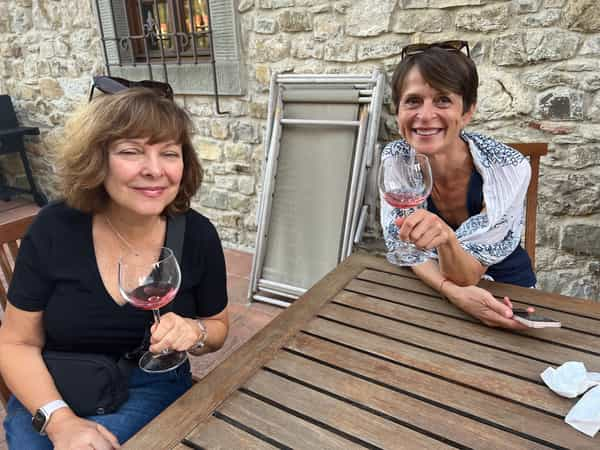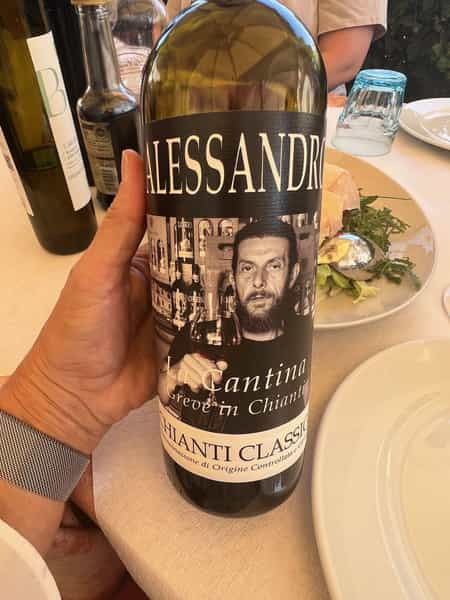One thing you may not realize about The Chopping Block's Cook Like a Tuscan tour is that it is just as much focused on the wine of Tuscany as the regional cuisine. Whether you already know the difference between a Chianti Classico and a Chianti Reserva or you have trouble deciphering Italian wine labels, this trip will take your wine knowledge to a new level.
One of your tour guides is Viktorija Todorovska. Viktorija is an accredited Sommelier, Italian Wine Scholar and Certified Specialist of Wine. Those of you who have been taking classes at The Chopping Block for a while will remember her as our sommelier (and blogger) from around 2015 to 2020. Viktorija's wine classes were always popular because she has a special talent for explaining the sometimes incredibly complexities of wine in a way that everyone can understand.
 Tour guides Peggi and Viktorija
Tour guides Peggi and Viktorija
Viktorija does the same on the Cook Like a Tuscan tour now. Each day, there's some level of wine education, whether you are sipping Prosecco at the villa overlooking the vineyards or in Montalcino tasting some of the best Brunello of your life. You'll also learn from wine experts throughout Chianti as you stop at vineyards and local restaurants.
The first sip of wine you will drink is at the first meal at Ristorante Pizzeria La Cantina in Greve in Chianti. You'll meet the owner Alessandro and taste your first Chianti Classico, complete with his photo on the label.
 From there, your wine journey doesn't stop. You'll learn about interesting whites with Viktorija at the villa on the first night before dinner. That's when we learned that in order to pass the sommelier exam, you must open a bottle of sparkling wine silently. No pops and certainly no spillage allowed!
From there, your wine journey doesn't stop. You'll learn about interesting whites with Viktorija at the villa on the first night before dinner. That's when we learned that in order to pass the sommelier exam, you must open a bottle of sparkling wine silently. No pops and certainly no spillage allowed!
You'll toast the Italian way, "Cin cin" which is a casual and informal toast that is commonly used among friends and family. "Salute" is another way to say "cheers," which is more formal and is often used in more formal settings.
The first vineyard on the itinerary is Altiero which is a small production organic vineyard in Montefioralle. They only produce about 18,000 bottles of wine per year and every single grape (and olive for their olive oil) is grown on the property. Owner Paolo Baldini and his wife run the small operation and offer tours and meals in this scenic location. The views over lunch were simply amazing!
You'll learn that by Italian law, Chianti must be a minimum of 80% Sangiovese grapes though Altiero's Chianti is 100% Sangiovese. It must also be aged at least twelve months.
Everywhere you go in Chianti, you'll see the black rooster which is an important symbol because it distinguishes wine produced within the territory of Chianti Classico from those that have been produced outside of the area. The rooster's legend dates back to the Middle Ages during the war between Florence and Siena and it helped draw the lines of new territory. Read the fascinating tale here.
The next vineyard you visit is Badia a Coltibuono which is also where you will learn how to make homemade pasta in a place rich with history. Badia a Coltibuono is a former abbey founded in 1051 and was home to some of the first vineyard plantings in the region. More recently, it was the home of the late Lorenza De’ Medici, an internationally known cook, author, and authority on Italian cuisine. The estate is now owned by Lorenza’s three adult children and the cooking school is in the hands of Chef Patrizia who leads you in a hands-on pasta preparation workshop.
We also had the opportunity to tour the 1000-year-old abbey including the impressive wine cellar and Renaissance gardens.
Spend some time looking through the wine cellar for wines from your birth year. They have wines from 1936 to 1994!
The high acidity in Chianti carries wine through the aging process, but I'm not sure I want to drink wine that old!
I loved the wines at this winery so I was thrilled to return home and realize that The Chopping Block actually carries the Chianti Classico from Badia a Coltibuono! It's an incredible value at $34/bottle.
One of my favorite excursions on the tour was the journey south to the Val d’Orcia, a region carved out by the Orcia river that is truly beautiful. We spent the morning in Montalcino, a medieval walled hilltop city with a fortress and a 16th century go-back-in-history vibe, tasting Brunello di Montalcino.
You are on your own for lunch in Montalcino and there's plenty of time for shopping, but if you are like me and my friend Cheryl, you have a Brunello tasting flight with your lunch of charcuterie and cheese.
Brunello, which translates to "little brown one," is a clone of the Sangiovese grape but the skin to juice ratio is different. It's a robust wine, in fact, one of the most tannic red wines in the world. It's the only wine in Italy that has a legal requirement to age for at least two years in oak barrels then at least six months in bottles, but most age for much longer. In fact, ten to fifteen years is normal, which is one reason why this wine comes at such a high price point.
We learned on the way to Montalcino that Italian law does not allow any irrigation of crops. The Italians believe that if the vine cannot survive, it shouldn't be planted there. I admire the ideology but don't envy the growers! Brunello di Montalcino is one of the world's most sought after wines and has a cult following. Since these wines are typically out of my price point, I very much valued the experience of being able to taste 11 in one day, including the tasting and lunch.
Chianti used to be associated with a squat bottle enclosed in a straw basket, called a "fiasco" which translates to flask. But the fiasco is now only used by a few makers of the wine; most Chianti is bottled in more standard-shaped wine bottles. In fact, the only time we drank wine out of straw-covered bottles was at Dario Cecchini's restaurant in Panzano in Chianti. I write about that amazing day in detail in this post.
Viktorija taught us all about the category of wine called Super Tuscans, which is a category of Tuscan wine born in the 1980s. Super Tuscans are different from other Tuscan wines (like Chianti) because they use grapes that are not indigenous to Italy. French grape varietals are typically successful, specifically Cabernet Sauvignon, Merlot and Syrah. If you see the "IGT" classification on an Italian wine label, it's likely a Super Tuscan. This is a vast category of wine because it's not defined by law but rather gives winemakers more creativity.
But our wine tastings weren't always high end on this trip! We also had wines made by our chefs Mirella and Stephano that didn't even have a label on the bottle. Here's traveler Lisa showing off one of our dinner wines, which was absolutely lovely.
I also had wine served in a plastic cup when we had lunch at Dario's food truck. This Chianti paired perfectly with a burger on the side of the road.
Viktorija also treated us to a sunset wine pairing of a beautiful Tuscan white wine with spicy potato chips. Vermentino reminded me a lot of Sauvignon Blanc, which is my favorite white wine. It's light in body but complex in taste with snappy citrus, and I have to say, absolutely delicious with a spicy potato chip. Give this pairing a try!
On our last full day in Tuscany, we visited Azienda Agricola Fontodi for a wine tasting. Fontodi is a certified organic estate that has been owned by the Manetti family since the 1960’s. Our villa is part of the Fontodi estate, and we tasted their wines throughout the week so it was great to go to the source and learn about their winemaking and passion.
The process of vinification and ageing of Fontodi's Chianti Classico starts in stainless steel tanks with indigenous yeasts for at least 3 weeks.
It then moves to French oak barrels and casks for at least 18 months which takes place in the modern cellar, built on descending levels to take advantage of gravity.
Fontodi is a much larger operation than the previous winery we visited as they make closer to 300,000 bottles of wine a year, though it would still be considered a smaller production winery than we see from the typical large American operations. The grapes are still harvested by hand and 60 cows on the grounds produce the manure for the vines.
Two brothers run the Fontodi family company - one oversees the winery while the other oversees the terra cotta business, which makes, among many things, amphoras to hold their wine for aging. It was very interesting to see two wineries at very different sizes to see how they managed their land, harvests and wine production.
There was also plenty of Vin Santo, Italy's famous dessert wine which is typically served with biscotti, on this trip. I'm not a big dessert wine fan, but I did like the biscotti once it was dipped in it!
If you are interested in learning more about Italian wine, stop in our Lincoln Square store and talk to our staff. We currently offer seven wines from Italy (including that delicious Chianti) to choose from.
But for the ultimate Tuscan wine experience, I cannot recommend the Cook Like a Tuscan tour more. Before I went on this trip, I was a bit intimidated by Italian wine because it seemed so complicated with all of the rules surrounding regions and percentages of grapes used in the wine. I now seek out Italian wine in my local wine store and am having lots of fun trying to find the same wines we tasted on the tour. What I learned on the tour has opened up a whole new world of wine for me, and it can do the same for you!


